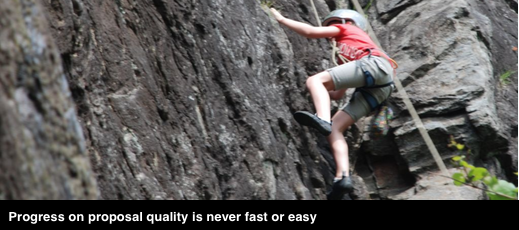Recent posts covered proposal win-loss reviews, using FOI requests, and a process for assessing competitors’ proposals. If you’ve taken these steps to evaluate your proposals, you likely have a list of improvement priorities.
So, let’s get started.
The big picture
Every formal proposal competition has a deadline. The goal of any improvement plan is to make better use of the available time. That’s the aim of all five ideas below. Based on your analysis and internal practices, decide which are priorities for your team.
1. Make faster bid/no-bid decisions
Speedy decisions are vital in maximizing the time you have to respond. If your company makes its bid/no-bid decision within a few days of the RFP release, you can skip this step. But if that decision typically drags on, see this post on making proposal bid/no-bid decisions.
2. Develop and document stronger strategies
If analysis shows your proposals need to do a better job of linking features and benefits to prospect issues, start by assembling the arguments you’ll need. See this post on proposal strategy making to get started.
3. Improve writer guidance
To obtain high quality content, it’s critical to communicate strategy to writers, along with their assignments and schedule. This is a weakness in most client processes. We recommend providing section planners and content prompts at kickoff to drive consistency across all sections. We’ll post on these tools in the coming months. Meanwhile, see this post on aligning proposal writers at kickoff.
4. Manage more closely
Allowing subject managers experts (SMEs) a week or more to deliver first drafts is risky. Given the competing priorities most face—plus the temptation to procrastinate—that deadline is likely to come and go with substandard deliverables, or none at all. Instead, schedule a bullet point review within three or four days of kickoff to assess each SME’s analysis and content plan. Then conduct further progress reviews every couple of days. This process may seem burdensome, but in fact it bite-sizes the writing job and reduces wasted effort. For further ideas, see this post on proposal management.
5. Line up the sponsorship you’ll need
You’re going to need executive support to enact your plan because:
- Implementing 1 and 2 involves changing the way company leaders participate in the proposal process, and;
- Implementing 4 and 5 changes how writers are managed. SMEs who are not your direct reports—especially if proposals lie outside their defined responsibilities—are likely to resist. In these cases, you’ll need executive backing.
Prepare for patient progress
Improving proposals—especially in larger companies—always involves organizational change. This inevitably means getting stakeholders on-board with a set of goals and roadmap. Success takes a solid plan with clear milestones and deliverables, strong communication skills, one or more executive sponsors—and patience.


